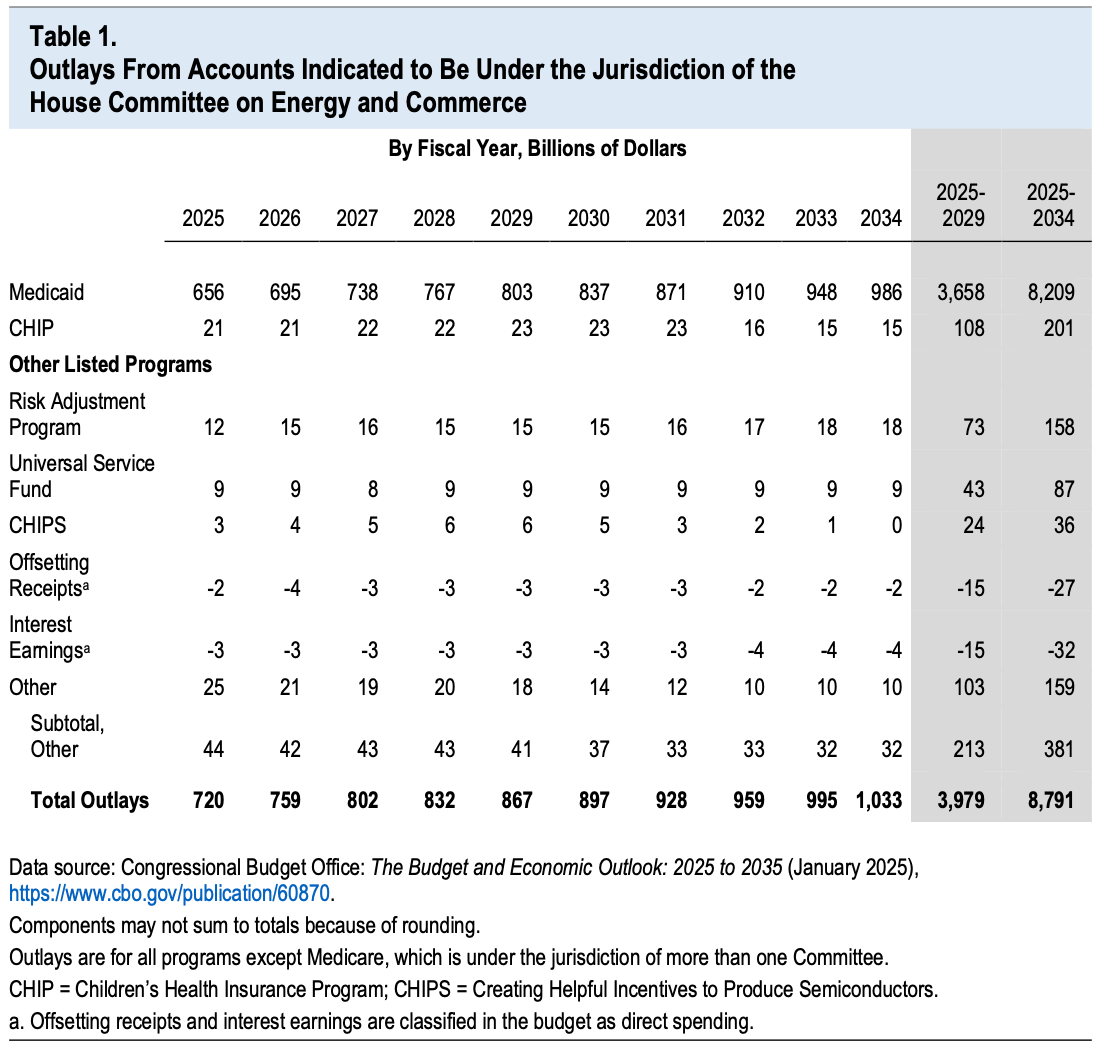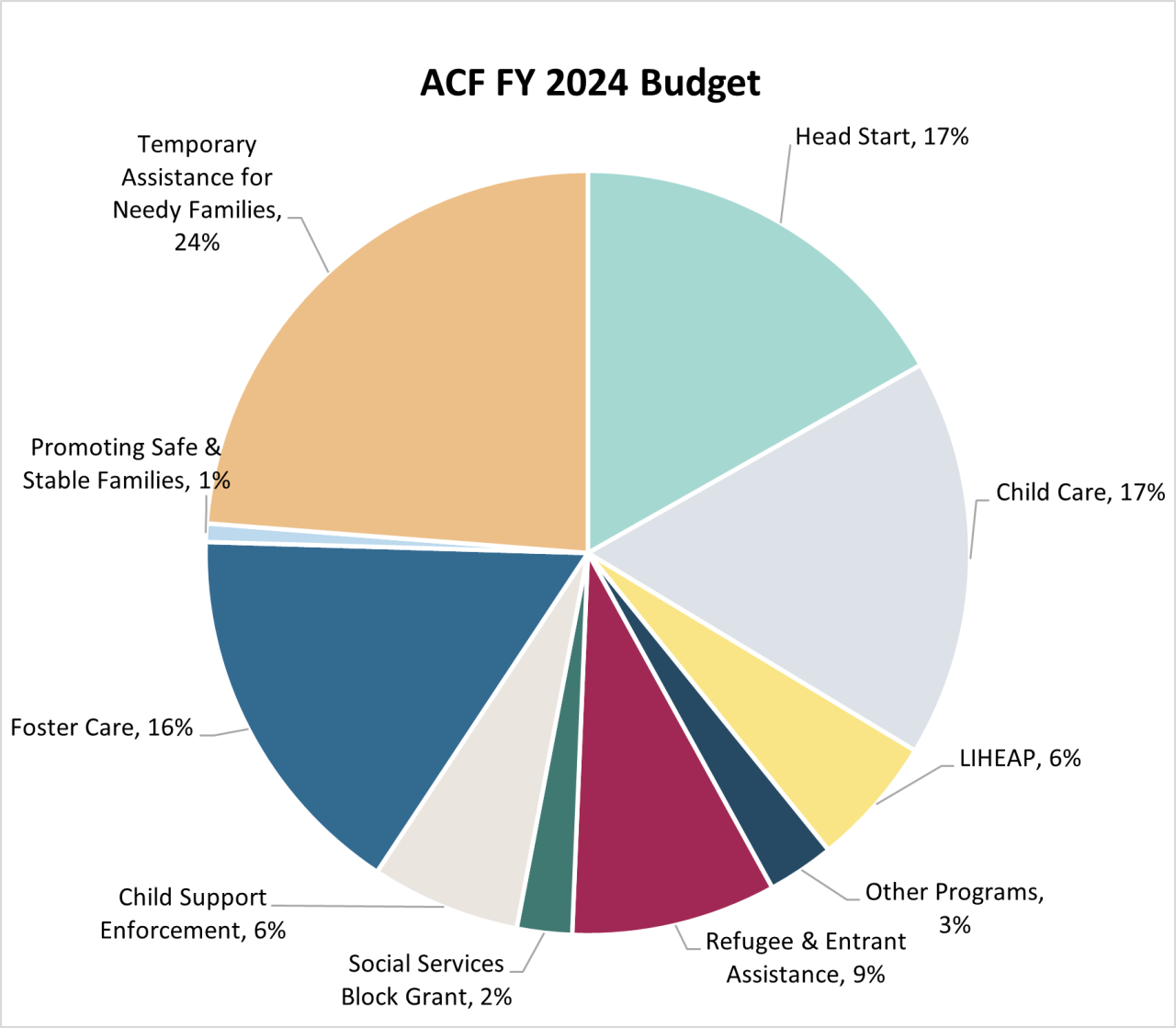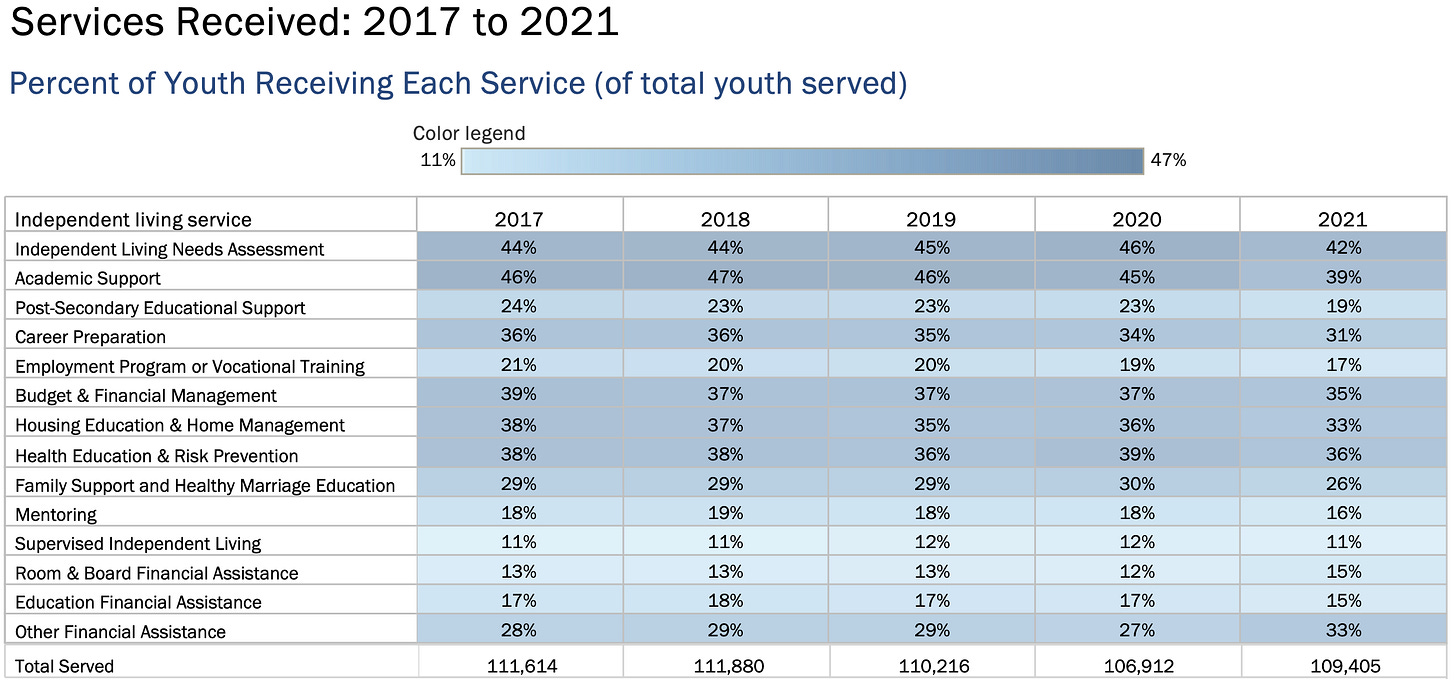Shutdown Watch, Child Welfare Style
Instead of stress baking, here's some pivot tables of all the FY24 ACF earmarks...
Welcome, Wonks! Fellow parents of young children on the day after a clock change- why do we always fool ourselves into thinking this time will be better? Alas…
This week we’ve got timely news on bipartisan legislation, new data relevant to reconciliation, a deep dive on FY2025 appropriations, and more. Let’s get after it!
Child Welfare Policy News
House Passes Bipartisan Foster & Adoptive Parent Recruitment Legislation
On March 4th the U.S. House passed the Recruiting Families Using Data Act (H.R. 579) by voice vote.
The bill is focused on using data-driven strategies to improve recruitment and retention of foster and adoptive families, an approach states are increasingly using.1
Representatives Randy Feenstra (R-IA) and Brendan Boyle (D-PA) co-led the bill, which would require new data and reporting under Title IV-B of the Social Security Act.
The legislation would require states and tribes to create “family partnership plans,”addressing all aspects of recruiting and retaining foster and adoptive families.
States and tribes would need to report on foster family capacity and congregate care use, and provide annual analyses of barriers to family recruitment and retention.
This policy aims to address the challenges many states are experiencing identifying appropriate placements for children in care, and high foster parent turnover.
Now that the House has passed this bill, expect to see continued elevation of the policy from its Senate champions.
While You Were Weekending: Child Support Enforcement Data DOGE-d
The Trump Administration’s Department of Government Efficiency (DOGE, formerly the U.S. Digital Service2) has received access to child support enforcement data.
The U.S. Department of Health and Human Services (HHS) Administration for Children and Families (ACF) reports providing read-only access to the data system.
Those not in the weeds of child support enforcement may wonder about coverage of this seemingly picayune data at ACF’s Office of Child Support Services (OCSS).
OCSS runs the National Directory of New Hires (NDNH), created with the Personal Responsibility and Work Opportunity Reconciliation Act (P.L. 104-193, PRWORA).3
As the name implies, the system tracks all new hires. If you’ve ever filled out a Form W-4 for tax withholding when starting a job, you’re in the NDNH!
If you’re wondering why the system tracks everyone, and not just those paying child support, it’s to be able to enforce child support whenever it does become necessary.
The NDNH covers personal and financial data on all working people in the U.S. You can learn more about the NDNH from this Congressional Research Service report.
CBO Confirms Medicaid Math
At the risk of giving Jan Brady vibes about Medicaid, Medicaid, Medicaid, we have some important new data from the nonpartisan Congressional Budget Office (CBO).4
Since this is a reconciliation update, here’s your handy Child Welfare Wonk refresher:
Reconciliation Reminder
Overall Process
Check out our reconciliation overview (which also has a TANF deep dive)
Senate: Taking Two Steps
Less likely child welfare impact now, but more in a second bill later.
House: One “Big, Beautiful Bill” (see our update last week on their vote)
Comprehensive, significant child welfare implications (especially Medicaid)
What Matters for Child Welfare in Potential Reconciliation $ Reductions:
Medicaid
99% of kids in foster care, 7% of federal child welfare funds5
Temporary Assistance for Needy Families (TANF)
19% of federal child welfare spending
Social Services Block Grant (SSBG)
10% of federal child welfare spending
The House passed its budget resolution last week. Now the House and Senate must agree on an approach. That’s paused for now to avert a shutdown (see below).
The news to highlight this week is that CBO prepared a new report in response to a request about where potential spending reductions could come from.
Reps. Frank Pallone (D-NJ) and Brendan Boyle (D-PA), Ranking Members of the Energy and Commerce and Budget Committees, respectively, requested this report.
They asked CBO to calculate all of the non-Medicare6 outlays in Energy and Commerce jurisdiction over the next ten years, to see where savings could come from.
That focus is because the House budget resolution asks Energy and Commerce to generate $880B in savings during that time period.
Here’s what CBO shared:
$8.8T: Total Relevant E&C Spending (2025-2034)
$8.2T: Total Medicaid Spending (2025-2034)
93%: Total Relevant Spending Represented by Medicaid
$880B: Savings House Budget Resolutions Requests from E&C (2025-2034)
And here’s a handy chart to further illustrate:
This math is why the reconciliation conversation keeps returning to Medicaid, even before the committees begin drafting. We’ll continue to monitor this for you.
Deep Dive: FY25 Appropriations and Child Welfare
If things weren’t hectic enough, government funding for discretionary spending only runs through this Friday, March 14th. So what does that mean for child welfare policy?
ACF is a key agency for child welfare policy. This handy chart breaks its ~$72B total FY24 budget by focus, including mandatory and discretionary funds.
Mandatory Funding: Funding is set by law automatically, and does not need a new agreement each year. Child welfare examples include:
Medicaid;
TANF;
SSBG;
Parts of Title IV-B;
Almost all of Title IV-E;
Discretionary Funding: These funds are at the discretion of Congress, which must approve them annually. Child welfare examples include:
Child Abuse Prevention and Treatment Act (CAPTA);
Parts of Title IV-B; and
Education and Training Vouchers under Chafee.
On March 8th, U.S. House Speaker Johnson released a proposed Continuing Resolution (CR) to fund the government through September (end of the fiscal year).
This CR keeps many allocations level to FY 2024, but would reduce non-defense discretionary spending by about $13B and increase defense funding by about $6B.
Much of the discretionary spending cuts come from reducing Congressionally Directed Spending (AKA The Artist Formerly Known As Earmarks).
Here’s what level funding looks like for key discretionary child welfare programs:
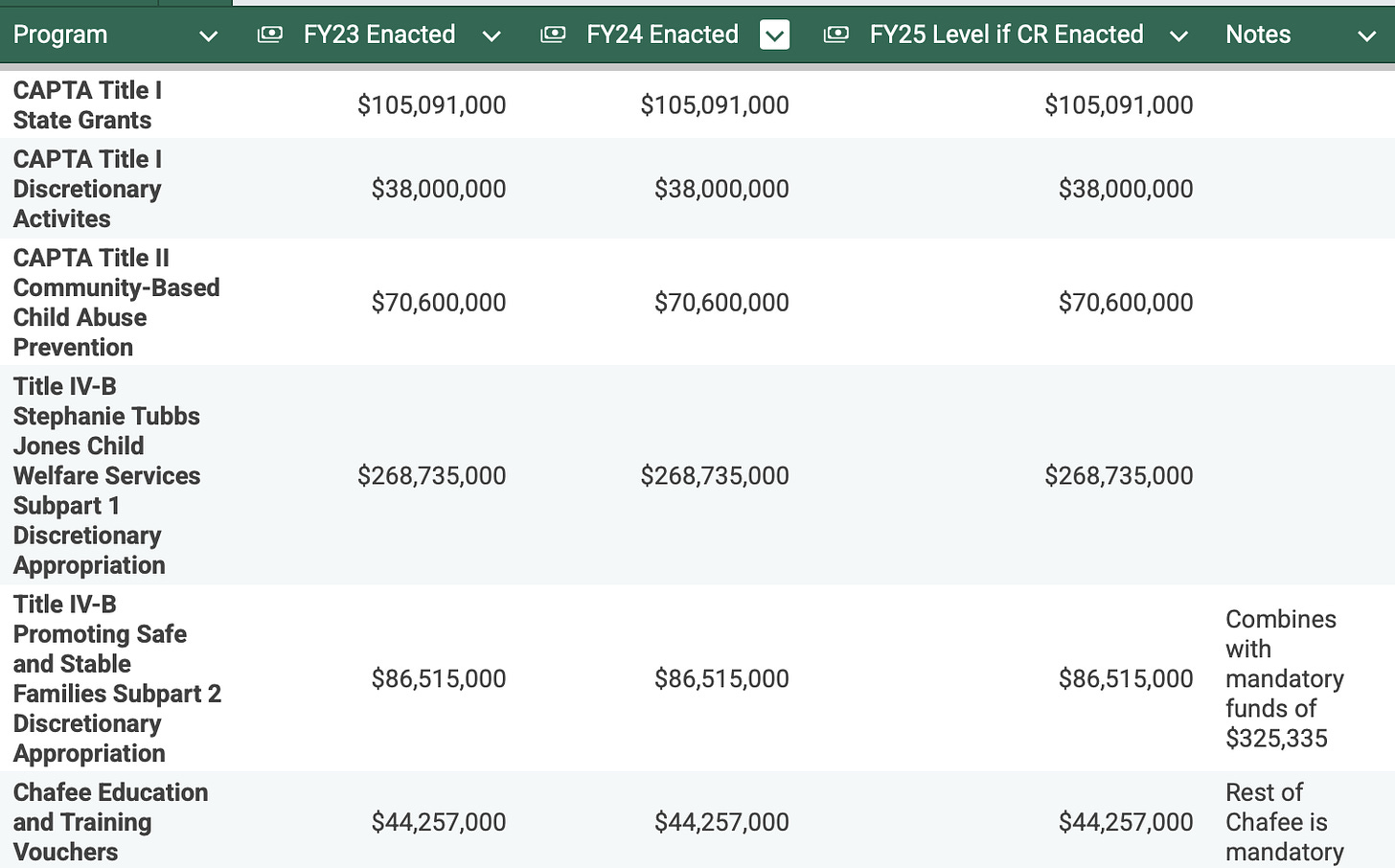
Okay, so those continue apace. But how do those earmarks affect child welfare?
Those are a bit more difficult to parse, because they typically come in wonkadelic charts like this. In an age of AI they are barely searchable and have no tabulations.
But, never fear wonks! Somebody had to review all 72 of the ~$40M in Congressionally-directed ACF projects. So I did, and I even made you pivot tables7.
Why bother? Because it’s almost half of what we spend on CAPTA state grants, over half of CB-CAP grants, and ~equivalent to Chafee ETVs! We should know what it is.
To break this down, I coded8 each project according to its description:
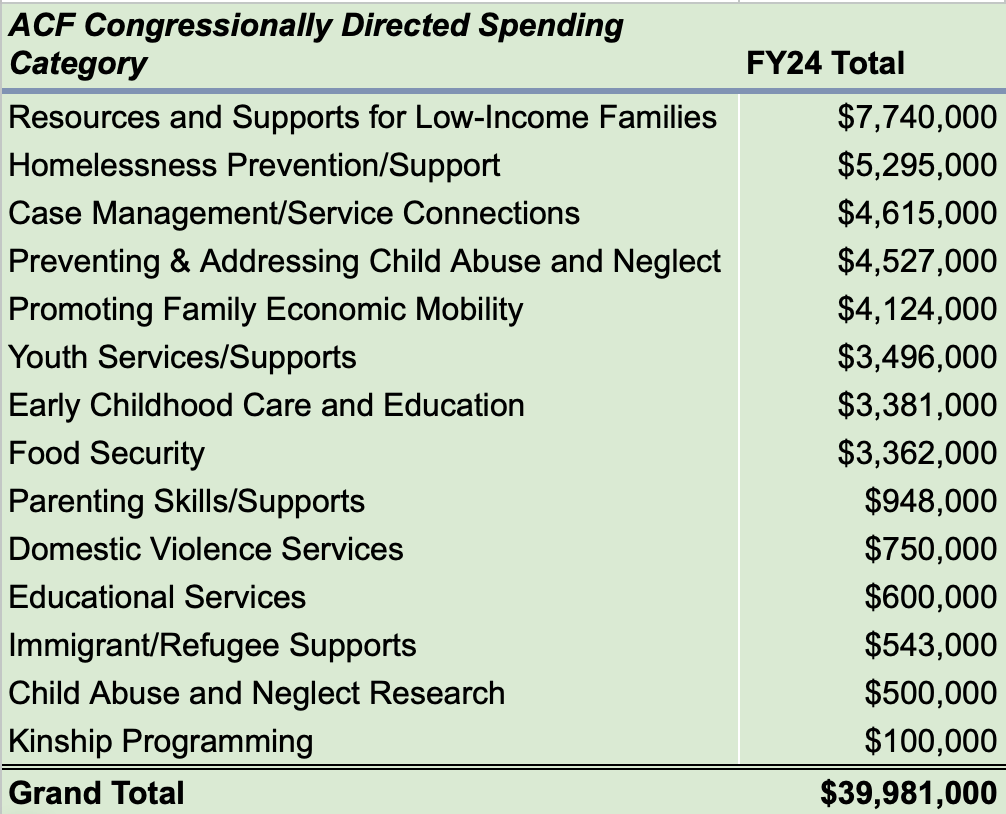
In addition, here’s total project awards by state, covering half the states9:

None of these projects would continue under a CR. Some other notes on a CR:
Flexibility. An administration has more leeway to reprogram funds to other purposes under a CR. This one has very broad categories to allow that.
Uncertainty. It’s harder to start new projects, execute contracts, or hire with short-term funding. Many programs take a cautious approach during a CR.
Nothing is yet set in stone on a CR this week. Expect further brinksmanship and a nonzero probability of a shutdown. We will keep you apprised as always.
Go Deeper: See the Full Project List
Datasets You Oughta Know: NYTD
Last week we kept breaking down data sets you oughta know with NCANDS.
This week, we cover the National Youth in Transition Database (NYTD)
Data You Oughta Know: National Youth in Transition Database
Who Manages It: ACF
Where Does it Come From: State surveys of youth.
What Do They Report:
Every young person Chafee Program agencies fund/ provide independent living services for.
Independent Living Services Reporting includes financial assistance and 11 categories of services:
Independent living needs assessment;
Academic support;
Post-secondary educational support;
Career preparation;
Employment programs or vocational training;
Budget and financial management;
Housing education and home management training;
Health education and risk prevention;
Family support and healthy marriage education;
Mentoring; and
Supervised independent living.
Demographic/outcome data over time for some10:
Youth reports on six outcomes of interest
Financial self-sufficiency
Experience with homelessness
Educational attainment
Positive connections with adults
High-risk behavior, and
Access to health insurance.
Why Do They Report It: The Foster Care Independence Act of 1999 (P.L. 106-169) created the Chafee Program and requires it. Collection began in FY2011.
What Reports Does it Create?
Additional Data to Dig In
What Kind of Stuff Does it Tell Us:
Why You Oughta Know: This is a key resource for information about services to and outcomes for youth.
Have a good week, Wonks!
For more on this, check out the Children Need Amazing Parents Campaign.
And confusingly, technically not a department.
Yes wonks, truly everything seems to go back to ‘96 welfare reform. If you really want to go down the rabbit hole, here’s The Atlantic on ODB’s role in ‘96 welfare reform.
And no, it’s not from our analyst friend George Glass, it’s a legit report!
Because Medicare is exempted in this reconciliation effort
The full breakdown of each project is organized by states at this longer chart if you want to go deeper.
Disclaimer- this is more art than science. These are 1-2 sentence descriptions max, so I tried to get some basic categories.
Wonks will note that it doesn’t hurt to be in a state with an appropriator…



